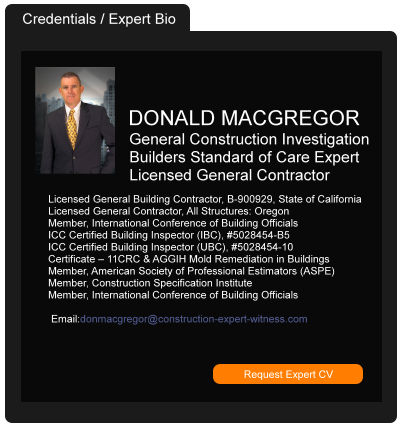Arizona Supreme Court Confirms a Prevailing Homeowner Can Recover Fees on Implied Warranty Claims
August 30, 2017 —
Rick Erickson - Snell & Wilmer Real Estate Litigation BlogOn August 9th, in Sirrah Enterprises, L.L.C. v. Wunderlich, the Arizona Supreme Court settled the question about recovery of attorneys’ fees after prevailing on implied warranty claims against a residential contractor. The simple answer is, yes, a homeowner who prevails on the merits can recover the fees they spent to prove that shoddy construction breached the implied warranty of workmanship and habitability. Why? Because, as Justice Timmer articulated, “[t]he implied warranty is a contract term.” Although implied, the warranty is legally part of the written agreement in which “a residential builder warrants that its work is performed in a workmanlike manner and that the structure is habitable.”
In other words, a claim based on the implied warranty not only arises out of the contract, the claim is actually based on a contract term. Since, in A.R.S. § 12-341.01, Arizona law provides for prevailing parties to recover their fees on claims “arising out of contract” and because the implied warranty is now viewed by the courts as a contract term, homeowners can recover their fees after successfully proving breach of the implied warranty.
Read the court decisionRead the full story...Reprinted courtesy of
Rick Erickson, Snell & WilmerMr Erickson may be contacted at
rerickson@swlaw.com
Ninth Circuit Reverses Grant of Summary Judgment to Insurer For Fortuitous Loss
July 01, 2019 —
Tred R. Eyerly - Insurance Law HawaiiThe Ninth Circuit reversed the district court's issuance of summary judgment regarding coverage for damages when the insured's plant had to be shut down due to an accident. Ingenco Holdings, LLC v. Ace American Ins. Co., 2019 U.S. App. LEXIS 10946 (9th Cir. April 15, 2019).
Ingenco operated a gas purification plant which converted raw landfill gas into usable natural gas. The final step in the purification process involved the removal of excess nitrogen from the landfill gas. The gas was directed through adsorbent beads, to which nitrogen adhered, contained within pressure vessels.The beads could not withstand the direct pressure of the landfill gas inflow. which, if untreated, could grind the beads down into dust. To reduce the force of the gas flow on the beads, a "diffuser basket" was suspended from the top of each bead-filled pressure vessel. The diffuser basket acted as a shield that prevented the full force of the incoming landfill gas from striking the beads directly.
In 2010, metal brackets securing a diffiuser basket broke. This resulted in damage to other components and an eventual shutdown of the entire facility. The plant remained idle for several months as Ingenco investigated alternative nitrogen filtration options and undertook repairs.
Read the court decisionRead the full story...Reprinted courtesy of
Tred R. Eyerly, Damon Key Leong Kupchak HastertMr. Eyerly may be contacted at
te@hawaiilawyer.com
No Signature, No Problem: Texas Court Holds Contractual Subrogation Waiver Still Enforceable
April 10, 2023 —
Gus Sara - The Subrogation StrategistIn Chubb Lloyds Inc. Co. of Tex. v. Buster & Cogdell Builders, LLC, No. 01-21-00503-CV, 2023 Tex. App. LEXIS 676, the Court of Appeals of Texas, First District (Court of Appeals) considered whether the lower court properly dismissed the plaintiff’s subrogation case by enforcing a subrogation waiver in a construction contract which was not fully executed. The contract was signed by only one of the two subrogors and was not signed by the defendant general contractor. The Court of Appeals affirmed the trial court’s decision, holding that despite the lack of signatures, the evidence established mutual assent to the contractual terms by all parties.
The plaintiff’s subrogors, Jeffrey and Mary Meyer (collectively, the Meyers), retained defendant Buster & Codgell Builders (BCB) to expand their residence. BCB drafted a contract using the American Institute of Architects (AIA) standard form contract for residential construction. The AIA contract included, by reference, a subrogation waiver that applied to BCB and its subcontractors. Prior to beginning the work, BCB emailed Jeffrey Meyer a version of the contract that only had one signature block for both Jeffrey and Mary Meyer. Minutes later, BCB sent a second version of the contract which had a signature line for each of the Meyers. However, Jeffrey Meyer signed the first version of the contract and emailed it back to BCB. In the subject line of his email, Mr. Meyers asked that BCB countersign and return the contract. BCB did not sign and return the contract.
Read the court decisionRead the full story...Reprinted courtesy of
Gus Sara, White and WilliamsMr. Sara may be contacted at
sarag@whiteandwilliams.com
Takeaways From Schedule-Based Dispute Between General Contractor and Subcontractor
September 09, 2024 —
David Adelstein - Florida Construction Legal UpdatesA recent opinion out of the Southern District of Florida, Berkley Insurance Co. v. Suffolk Construction Co., Case 1:19-cv-23059-KMW (S.D.Fla. July 22, 2024), provides valuable takeaways on schedule-based disputes between a general contractor and subcontractor on a high-rise project.
In a nutshell, the general contractor’s original project schedule was abandoned due to project delays and the project wasn’t being built by any updated project schedule. The subcontractor claimed the general contractor was mismanaging the schedule putting unreasonable manpower and supervision constraints on it, i.e., it was working inefficiently. A bench trial was conducted and the Court found in favor of the subcontractor’s arguments. The Court found the general contractor had unrelated delays and that work activities were no longer methodical but, simply, piecemeal demands. The Court also rejected any inadequate manpower arguments finding the subcontract did not place any manpower requirements on the subcontractor.
Read the court decisionRead the full story...Reprinted courtesy of
David Adelstein, Kirwin Norris, P.A.Mr. Adelstein may be contacted at
dma@kirwinnorris.com
Professor Stempel's Excpert Testimony for Insurer Excluded
October 07, 2019 —
Tred R. Eyerly - Insurance Law HawaiiThe court denied Daubert motions for several experts with the exception of Professor Stempel's expert testimony opining that the insurer did not act in bad faith Adell Plastics, Inc. v. Mt. Hawley Ins. Co., 2019 U.S. Dist. LEXIS 102942 (D. Md. June 19, 2019).
A fire demolished several buildings at Adell's facility. Adell was insured under a commercial property policy issued by Mt. Hawley. Mt. Hawley sued Adell, seeking a declaration that it owed no coverage, and requesting recoupment of a substantial advance payment. Adell filed a counterclaim, alleging that Mt. Hawley had breached the policy and had acted with a lack of good faith. Before the court were several pretrial motions, including motions to exclude testimony of eight expert witnesses.
The court denied Adell's motion to exclude several experts to be called by Mt. Hawley. The accountant's testimony was relevant. Adell had to prove damages on its breach of contract claim, and the accountant's testimony would aid the jury in evaluating Adell's documentation and calculating documented damages. Mt. Hawley's fire safety expert investigated the Adell fire. Mt. Hawley had shown that his expert opinion would be sufficiently reliable for admissibility. Further, three fire protection engineers offered by Mt. Hawley and two fire protection engineers to be called by Adell were allowed to testify. Each expert based his investigation and conclusions on the standards of fire investigation as set out in the NEPA Guide for Fire and Explosion Investigations. This was a fire insurance case, and fire protection engineers would be allowed to testify and illuminate the circumstances of the fire.
Read the court decisionRead the full story...Reprinted courtesy of
Tred R. Eyerly, Damon Key Leong Kupchak HastertMr. Eyerly may be contacted at
te@hawaiilawyer.com
A Retrospective As-Built Schedule Analysis Can Be Used to Support Delay
May 23, 2022 —
David Adelstein - Florida Construction Legal UpdatesDelay claims are part of construction. There should be no surprise why. Time is money. A delay claim should be accompanied by expert opinions that bolster evidence that gets introduced. The party against whom the delay claim is made will also have an expert – a rebuttal expert. Not surprisingly, each of the experts will rely on a different critical path as to relates to the same project. The party claiming delay will rely on a critical path that shows the actions of the other party impacted their critical path and proximately caused the delay. This will be refuted by the opposing expert that will challenge the critical path and the actions claimed had no impact on the critical path (i.e., did not proximately cause the delay). Quintessential finger pointing!
This was the situation in CTA I, LLC v. Department of Veteran Affairs, CBCA 5826, 2022 WL 884710 (CBCA 2022), where the government terminated the contractor for convenience and the contractor claimed equitable adjustments for, among other things, delay. The contractor’s expert relied on an as-built critical path analysis by “retrospectively creating updates to insert between the contemporaneous updates.” Id., supra, n.3. The government’s expert did not do a retrospective as-built analysis and relied on only contemporaneous schedule updates. Id.
Read the court decisionRead the full story...Reprinted courtesy of
David Adelstein, Kirwin Norris, P.A.Mr. Adelstein may be contacted at
dma@kirwinnorris.com
Drones Give Inspectors a Closer Look at Bridges
January 02, 2019 —
Aileen Cho - Engineering News-RecordTed Zoli, national chief bridge engineer with HNTB, compares bridge inspections to taking his kids to the doctor. “Every few years you take another set of pictures of the bridge, and ultimately you can pattern it. You pay attention in a deeper way to responses, and have a record.” But like parents who don’t want to send kids to the doctor at the first sign of a sniffle, once managers understand the characteristics of a bridge and its behavior, they don’t need to do constant in-depth reinspections. They are constantly looking for ways to make better decisions with the data they already have. “We spend a lot of money inspecting bridges,” says Zoli. “The question becomes whether there is a more technologically efficient way to do it.”
Read the court decisionRead the full story...Reprinted courtesy of
Aileen Cho, ENRENR may be contacted at
ENR.com@bnpmedia.com
Revisiting OSHA’s Controlling Employer Policy
December 21, 2017 —
Wally Zimolong - Zimolong LLCThe United States Court of Appeals for the 5th Circuit has been asked to review OSHA’s twenty year old “controlling employer” policy. As many contractors are surprised to learn, under OSHA’s controlling employer policy, you can be given an OSHA citation even when your own employee is not exposed to the alleged hazard.
A. The Controlling Employer Policy
OSHA’s current controlling employer policy has been effective since 1999. That policy applies to multi-employer worksites, which means virtually all construction sites. Under the policy, OSHA can cite the creating, exposing, correcting, or controlling employer. A creating employer is one who creates the hazard to which workers are exposed. The exposing employer is one who permits his employees to be exposed to the hazard, whether it created the hazard or not. The correcting employer is one who is responsible with correcting known hazards. Finally, the controlling employer is one “who has general supervisory authority over the worksite, including the power to correct safety and health violations itself or require others to correct them.” Most general contractors and CM’s are controlling employers.
Under OSHA’s policy, a contractor’s OSHA safety obligations hinges on whether it is a creating, exposing, correcting, or controlling employer. The creating, exposing, and correcting contractors obligations are fairly straightforward. However, the controlling contractors obligations are more nuisanced.
Read the court decisionRead the full story...Reprinted courtesy of
Wally Zimolong, Zimolong LLCMr. Zimolong may be contacted at
wally@zimolonglaw.com

































































